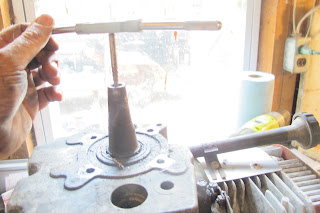We've been bodging along on summer repairs and projects like an old bodger should.
The old Troy-Bilt tiller that does our mid-season garden work is a good example. It broke down because the drive pulley bolt sheared. Left with a broken tiller up at the garden and a workshop full of tools needed to repair said tiller, I needed some help with lifting and carrying the tiller to the shop. Turns out the Kubota tractor loader can accommodate a tiller -- but only just. Not wanting to damage either piece of equipment or ourselves, we went very slowly indeed.
You can see the sheared bolt in the end of the driveshaft. That bolt fragment needed to be removed, a classic fitter's problem.
I opted to put the whole engine on the drill press. That gave me a nice, straight, clean hole in which to insert an Easy-Out type bolt extractor.
You can use vice grips or an adjustable spanner to grab the squared-off end of an Easy-Out and turn it, but the handle for a set of taps gets you a more even pressure.
And the result. A clean extraction. After a trip to the hardware store for new fine-thread bolt, I put the whole thing back together again, and it made it back to the garden under its own power, where we promptly weeded a row or two.
The other project is, off course, our old VW van, currently under reconstruction. Here's what VW is pleased to call the "B-post", a structural component that holds up the roof, after I removed all the rotten metal.
And here it is after I welded new metal in. I have about fifteen or twenty repair panels either ordered or already arrived to repair this van, but there will still need to be lots of these kinds of patches, made out of stock mild steel sheet metal. With this thin 22-guage sheet metal, I use the MIG welder, which I'm only just learning to use. I'm starting with out-of-the-way places like this so I can build up my skill.
Here's another example of a repair. This is the main frame member on the driver's side. On the left you can see a new patch, on the right is rotten metal awaiting removal. I had to repair this part is sections because to do it all at once would have bent the VW's shape.
Here's the rear of the same part, showing a completed patch.
I use the Lincoln Electric "tombstone" type stick welder for this heavier kind of work. This "new" metal, actually recycled from an old oil tank, is 12 gauge, just under 1/8th of an inch thick. The old chassis is 2 mm, just under 1/10th of an inch, so the new is thicker and stronger than the old, and is worked in with the stick welder all around the rear torsion bar. You can't weld to rust, it's true. But with a stick welder you can cut rust out of the way, or fuse it into "new" metal.
It isn't artistic, but it's strong, and will give a new lease of life to this van, which is otherwise only good for the scrapheap.
This is what I look like after a day of this kind of work. Old cars are filthy with road dust and rust. The job will get cleaner as it goes along. Eventually this vehicle will be so clean and bright, with new paint everywhere, you'd have a hard time getting dirty at all while working on it.
Meanwhile, back at the farm end of the Womerlippi operation, the pigs got some beer. This was some of the nasty stuff that breweries make for people that really don't like the taste of beer, so they put in fruit to cut the taste. In this case it was blueberries. I hate fruity beer, so if someone brings me some, I have to pass it on to someone else, or get rid of it some other way.
The pigs seemed to like it fine, despite the fruit. There's no accounting for taste.
Finally, Aimee's new chickies, now around ten weeks old, were exploring and invaded my workshop! Ernie was desperate to be given the job of herding them out, but that seemed like a recipe for disaster, so I made him go on the porch instead, and they left quietly of their own accord.














No comments:
Post a Comment
Welcome to our Farm Blog.
The purpose of this blog is for Aimee and I to communicate with friends and family, with those of our students, and other folks in general who are interested in homesteading and farming activities.
The earliest posts, at the very end of the blog, tell the story of the Great Farm, our purchase of a fragment of that farm, the renovation of the homestead and its populating with people and animals. Go all the way to the last post in the archive and read backwards from there to get it in chronological order.
After getting tired of spam comments (up to a dozen or more per day), I required commentators to be Google "registered users". You can write me at mwomersley@unity.edu if you have a serious comment or question and are not a registered user.
Spammers -- don't bother writing -- there's no way I will post your spam to my blog. Just go away.